If you've spent any time learning to improvise, even at the most beginner levels, you may have encountered certain notes that clash with the chord you are playing. If you are like me you may have thought "that's weird, I'm playing the scale that belongs to the chord, why does it sound so bad?" After studying a bit more, I learned that not all the notes in the scale are equally good choices.
So, what are "avoid notes?" An avoid note is any note in the scale that is a half-step away from a note in the chord being played. As an example, playing an F on top of a C major chord sounds dissonant, since it's a half step above E, the third of the chord.
There are some avoid notes you encounter often, like the F atop a C major chord mentioned above. Memorizing the most common ones is really useful as you progress. At the same time, jazz chords and scales are complex and plentiful. There are so many combinations that it's equally important to understand how to find avoid notes "on the fly" so you can improvise with care.
How to Identify Avoid Notes #
In the The Jazz Piano Book Mark Levine renames "avoid notes" as "handle with care notes." I have to say that I agree with that change. Jazz is an art where the rules are made to be broken -- and changed -- in the pursuit of creativity. And so, as a beginner it's safer to avoid those notes. As you progress you'll find more creative ways to use them intentionally.
In order to identify avoid notes, there are a few things you've got to have a solid handle on:
- You've got to know the notes of the chord and how you will voice it.
- You've got to know the notes of the scale you will use to improvise over that chord.
- If you are accompanying a melody, you've got to know the notes of the melody.
It's really important that these are ingrained in your mind. While the task of finding avoid notes is pretty simple, it requires you to do some thinking on-the-fly. That's when things can fall apart. You start focusing on what notes you can and can't play, and all of a sudden your brain has forgotten where you are in the form of the tune, or even what key you are in. You've got to have everything down cold so that you can dedicate your mental bandwidth to the task.
Here's how I do it, step by step:
- Identify the chord your are playing, and what the 4 major notes of that chord are.
- Identify what scale you are going to use to improvise over that chord.
- Now, look at that combination for any non-chord tones that are a half-step apart. Remember to look across octaves too. Minor-9th intervals are just fancy half-steps.
Any of these notes you found are avoid notes. Now, it's up to you as a creative performer to decide how to handle them.

Step-by-Step Video Training
As a premium member of Jazz-Library you will have access to our Jazz Fundamentals video course which has 70+ video lessons teaching you scales, chord voicings, soloing strategies and more.
Hearing the sound of avoid notes #
Before we get into too much theory explaining avoid notes, let's take a moment to experience what they sound like. By doing this, you'll start to hear these notes in our own playing, and can take note of places we can improve.
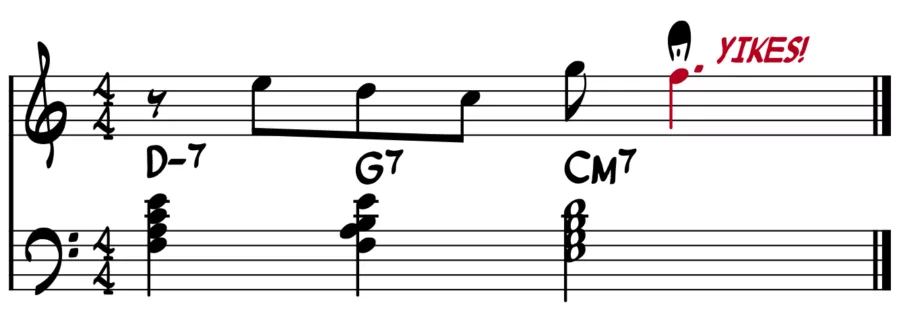
The dominant chord exception: #
It's worth noting that there are some really common exceptions to this rule when being used in dominant chords. By design, dominant chords are intentionally made to be dissonant, and so we often use chromatic alterations to add more dissonance. For example, a flat-9, sharp-9, and flat-13 are all technically "avoid notes" because they are dissonant, but they are used selectively in dominant chords for exactly that same reason.
Major Scale Harmony #
Lets look over each of the 7 modes of the major scale to see what avoid notes exist for each of them.
Major Scale (Ionian Mode) #
As our first example, the avoid note you'll encounter most often is the 4th scale degree on a major chord. In this case, we're playing a C-major scale on top of a CM7 chord, which is a perfectly logical choice.
The 4th note of the scale, F, is a half-step above the 3rd of the chord E, and therefore qualifies as an avoid note.
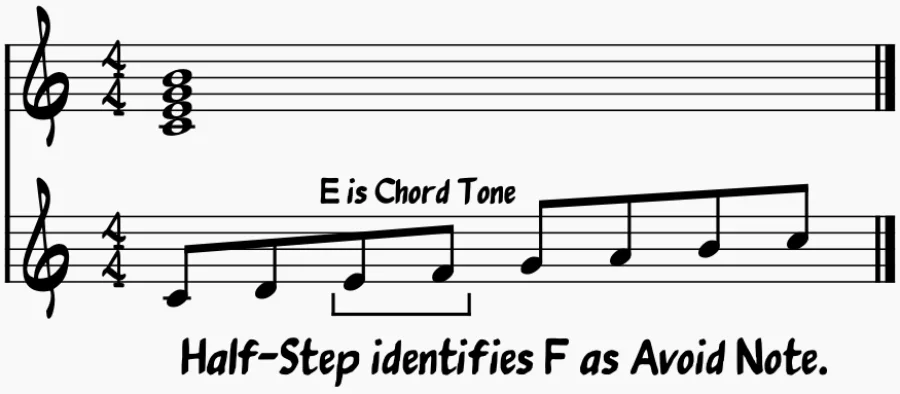
Dorian Mode #
In the Dorian mode, the 6th note is used cautiously as it's a half step below the 7th.
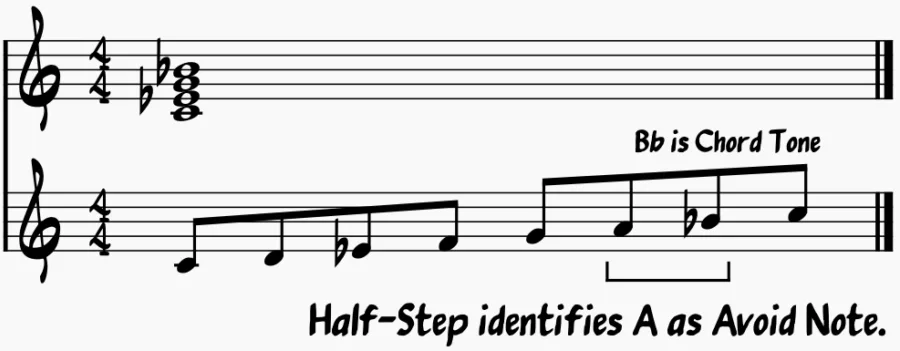
Phrygian Mode #
The Phrygian mode actually has two avoid notes, the flat-2 (clashes against the root) and the flat-6 (clashes against the 5th).
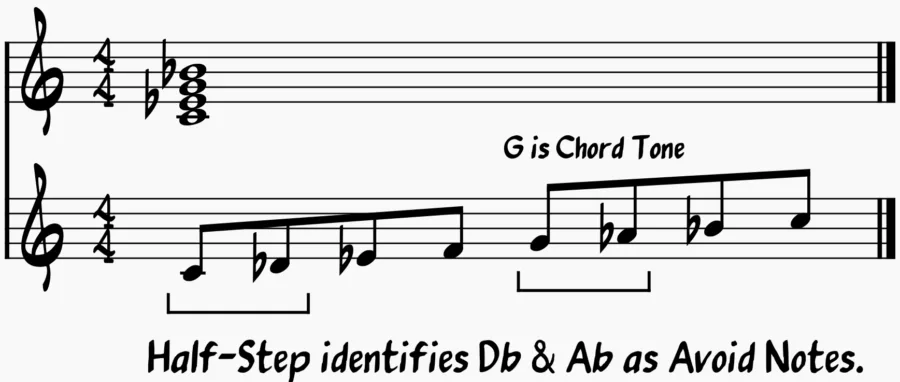
Lydian Mode #
There's some controversy around whether or note the Lydian mode has any avoid notes. From a technical perspective, the 4th note is an avoid note, as it is a half-step from the 5th. But, play it for yourself and see what you think. I think it sounds quite pleasing.
For this reason, many players prefer to play the Lydian scale over major 7 chords, even when they aren't strictly in the Lydian mode.
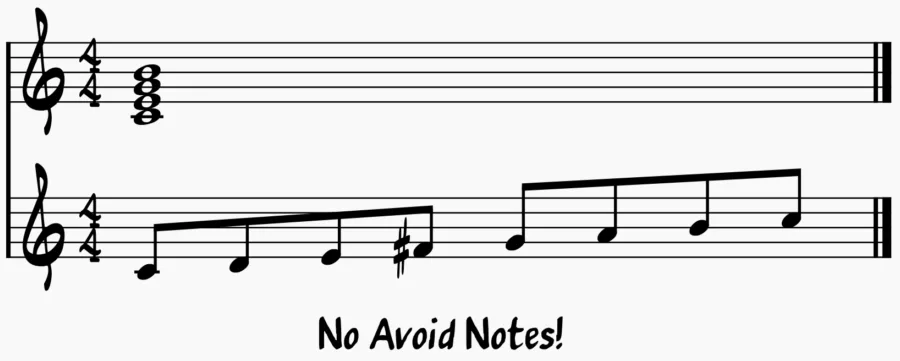
Mixolydian Mode #
Mixolydian has the same avoid note as the Ionian, the 4th note, which clashes with the major 3rd.
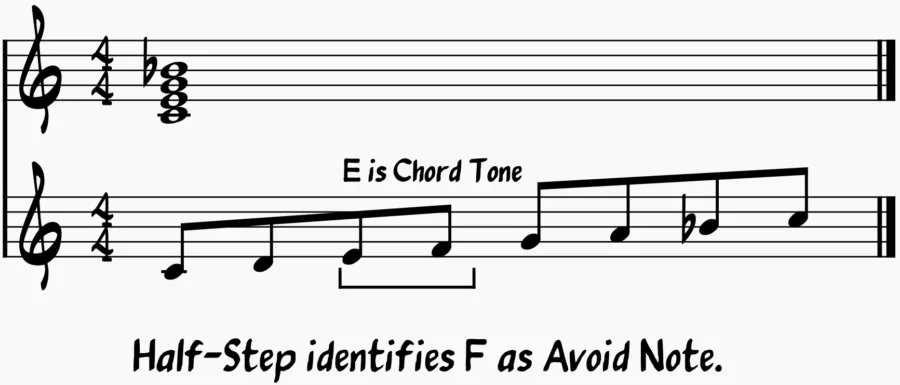
Aeolian Mode #
Aeolian shares an avoid note with Phrygian, the flat-6 against the 5th.
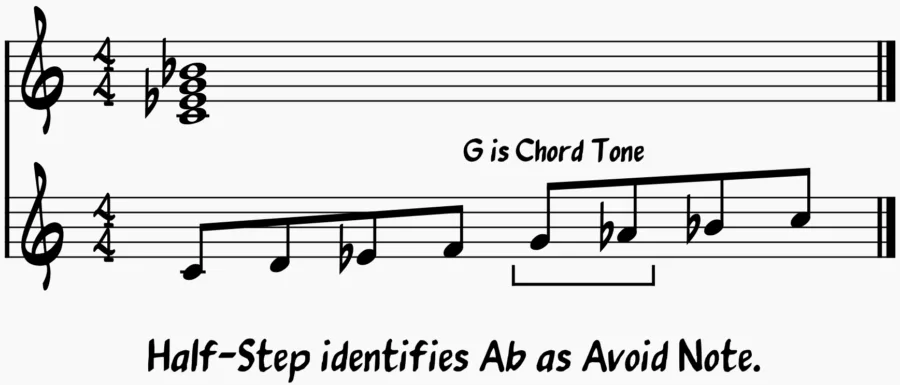
Locrian Mode #
Similarly, Locrian and Phrygian share the flat-2 avoid note, which clashes with the root.
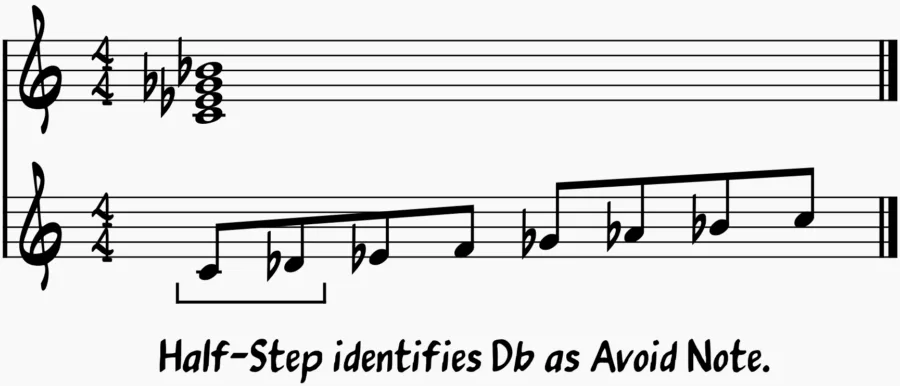
Locrian is an odd sound all around and isn't use that much.
Melodic minor scale modes #
It’s widely accepted that the modes of the melodic minor scale don't really have avoid notes. While I’m not sure that’s totally true, as there are dissonances to work around (the 6th should be handled carefully, for example), they are not nearly as dissonant as those in the major scale.
The 4th note in the major keys is the the most dissonant avoid note, as it clashes against the major 3. But since the melodic minor scale has a minor 3rd, the 4th isn’t a problem.
Considering avoid notes in your improv #
When improvising in a given key it’s tempting to think about just using notes from that keys major scale. After all, all diatonic chords in the key are made of notes from that scale. Why overwhelm yourself with the complexity of modes, when they all have the same notes?
As you’ve seen above, not all notes are created equal. Some notes are stronger than others, and some should generally avoided.Modes give us a way to keep track of these.
A simplified way to remember avoid notes #
This may seem like a lot to internalize just to remember a few avoid notes. And while that’s the most comprehensive approach, there is a simpler method I use with my beginning students.
- For Major 7 chords: avoid the 4th (11), flat-9 and flat-13
- For Minor 7 chords: avoid the major 3rd, flat-9 and flat-13
- For Dominant 7 chords: generally avoid the 4 (11), but really, anything goes.
Consider the melody #
If you are accompanying yourself or another musician, you need to consider the melody when identifying avoid notes as well. In fact, it's especially important against the melody note, even compared to chord tones.
One of the first things I learned when I started playing jazz was to avoid playing a major 7th chord when the melody note was the root. The 7th and root are a half-step apart. While the 7th is a chord tone, and therefore can't technically be an avoid note, it's crucial we don't do anything to clash with the melody. As a result, jazz pianists will substitute the major 7th for the 6th.
Ultimately, the rules that determine avoid notes are guidelines at best. It's to to your ear, musicianship and sense of taste to determine what you play and what you avoid.
